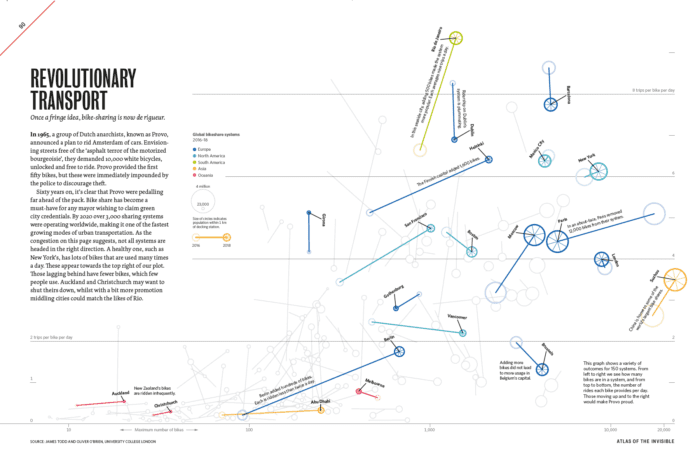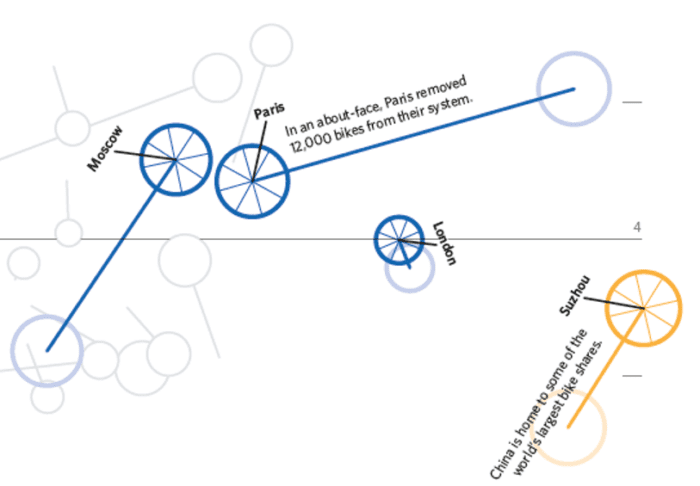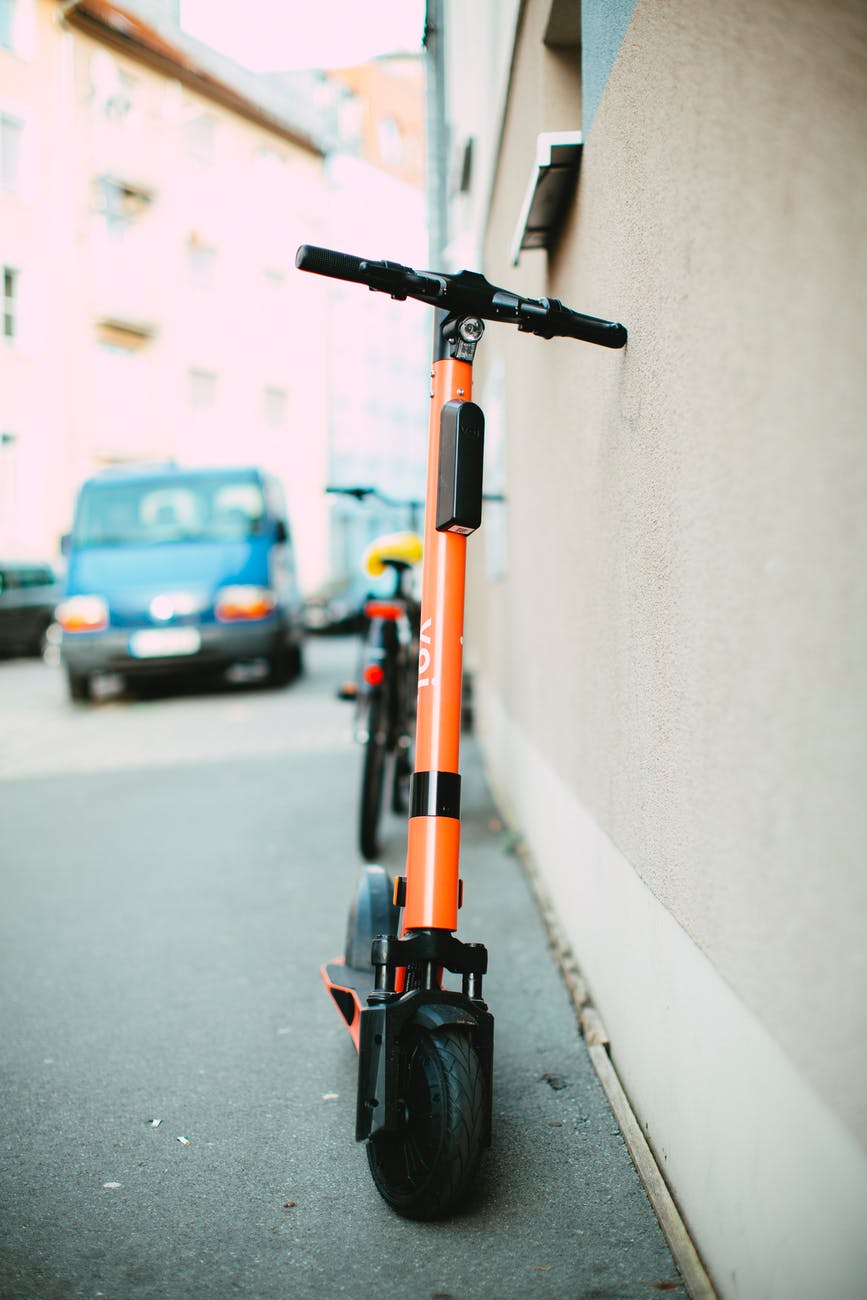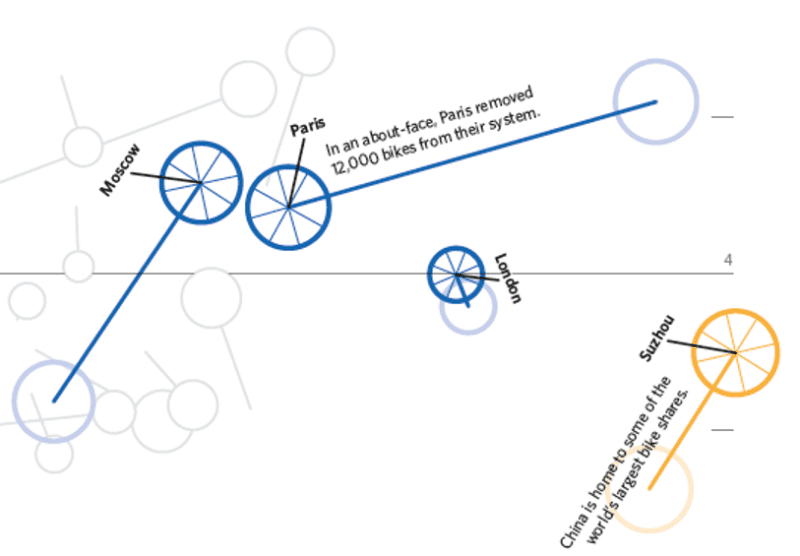Click here to access a Google Doc of these resources.
This graphic is a great example of how a range of fascinating data can be portrayed in one place. When you look at a graphic like this you need to take your time to make sure that you understand what it is showing and make the most of the richness of the data.

Reading the x and y axes
The x-axis (along the bottom) shows the maximum number of bikes available in each of the 150 bike sharing schemes.
The y-axis (up the side) shows the average number of times these bikes are used each day in each scheme.
Understanding the circles

The circles on this graphic are proportional symbols. They show the size of the population who live within 1km of the docking stations where the shared bikes are kept.
There are two circles for each bike sharing scheme represented. The first shows the situation in 2016 and the second in 2018. A change in their size for a place shows a change in the size of the population within 1km of a docking station.
A change in their position on the graph shows how the number of bikes in the scheme has changed and how the average number of trips per bike has changed.
Use of colour
Some of the 150 bike share schemes are labelled with places and shown in colours.
These colours indicate which part of the world the schemes are in and a key is used to explain this.
To check your understanding fill out the table below:
| Change in maximum number of bikes available ’16-’18 | Change in number of people living within 1km of docking station ’16-’18 | Change in average number of trips per bike per day ’16-’18 | |
|---|---|---|---|
| Girona | |||
| Brussels | |||
| Melbourne | |||
| Vancouver | |||
| Suzhou | |||
| Rio de Janeiro |
In 1965 a Dutch group demanded 10,000 bikes be made available to ride for free in Amsterdam. Why does the text on the graphic say that ‘Those [schemes] moving up and to the right would make Provo proud‘?
Guided reading

Quote 1: ‘Once a fringe idea, bike sharing is now de rigueur‘
‘De rigueur’ means that something has become fashionable or seen as the right thing to do. What does this phrase tell us about the authors view of bike sharing?
Quote 2: ‘asphalt terror of the motorized bourgeoisie‘
The bourgeoisie is the ruling class in society. Why did Provo think 10,000 free bicycles would combat this ‘terror’?
Look at the Revolutionary Transport graphic:
How does the graphic support the statement that the bike sharing scheme in New York is performing well?
How does the graphic support the statement that Auckland and Christchurch might want to shut their bike sharing schemes down?
Which ‘middling city’ do you think could match Rio with their bike sharing scheme if they promoted it more?
Why did you choose this city?
Global bikeshare – Co-benefits
When a scheme brings more than one benefit the additional benefits are known as co-benefits.
Bike sharing schemes are often introduced as a way of reducing traffic congestion and pollution in urban areas, helping cities become more sustainable. They also bring co-benefits for people’s quality of life.
Add the benefits below to the table. Can you add any further benefits?
- Cycling improves mood
- Cycling doesn’t release exhaust gases
- Bike share schemes can help cities gain awards for sustainability
- Bikes cost a lot less than cars and are easier to maintain
- Cycling builds muscle
- Use of bikes reduces traffic congestion and so cuts journey times
- Cycling cuts risk of heart disease and cancer
- Bikes can be used by people on low incomes and young people
- Less material is needed to make bikes than cars and they are easier to dispose of
- Cycle share schemes help councils to reduce greenhouse gas emissions
| Social | Economic | Environmental | Political |
|---|---|---|---|
Look at the Revolutionary Transport graphic and choose a location which needs to promote its bike sharing scheme to encourage more people to use it.
Which three points from your table would you use in a marketing campaign to promote the scheme?
Write a script for a 30 second radio advertisement to promote use of the bike scheme in your chosen location. You may like to do some research into the location to help you do this.
What obstacles are there?
Bike sharing schemes can be a great idea, but there are obstacles that need to be overcome if they are to bring benefits to the environment and people’s health.
The Bike-Sharing World Map shows you where bike share schemes can be found. This organisation estimates that there are 9.1 million bikes in sharing schemes across the world, with 8.6 million of these in China.
Too much of a good thing?
The first bike sharing schemes were usually set up by local governments and had ‘docks’ installed that bikes were taken from and returned to. Each town/ city would normally operate only one scheme, so there was no competition.
From 2016 onwards more ‘dockless’ bike sharing schemes have started. Rather than docks these use smartphone apps and GPS fitted to the bikes. This new technology reduced the cost of schemes and allowed the growth of private companies offering their services across hundreds of cities. This meant schemes had to turn a profit and competition between companies meant the prices they could charge users were driven down.
2017-18 saw some bike sharing organisations face boom and bust and many cities struggling to cope with discarded bikes as operators who failed left their bikes behind.
Target for vandals?
Dockless bikes can be left in many more places than bikes which are returned to a dock, so are harder to keep track of. They are also vulnerable to vandalism.
This has led to some providers using cheap, low quality bikes, which increases the numbers dumped. Dealing with vandalized bikes means repair teams have less time to maintain the fleet of bikes.
Can they co-exist with e-scooters?

E-scooters are now available to hire in many towns and cities, sometimes as part of bike sharing schemes and sometimes in competition. E-scooters are particularly popular with young people, but don’t bring the same health benefits as cycling.
How could bike share schemes overcome these obstacles?
- Would more local, small scale schemes make bike sharing more manageable?
- Do bright colours and brand logos make bikes more vulnerable to vandalism?
- Are schemes using docks better than dockless schemes?
- Does bike sharing need to be priced differently?
- Should bike share schemes include e-scooters?
What do you think?
How do you think bike share schemes should be run in the future? Think about:
- Economic sustainability
- Environmental sustainability
- Popularity
- Contribution to wellbeing












